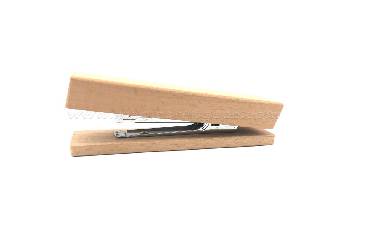The stapler is a tool that we often use in our daily life. Its function is to assemble the documents or papers that need to be nailed together by pressing them with nails through the stapler. Below we follow the Sunflower Earrings Supplier 1 Let's take a look at the structure of the stapler.
1. Working principle of stapler
The working principle of the ordinary Wooden Stapler is that when the manual force is pressed on the end cap of the stapler, the jack, needle and clamp will rotate around the connecting pin. With the continuous application of the manual force, the jack will rotate out of its natural state At this time, the jack will make an approximate up and down movement around the connecting pin that is slightly larger than a needle height, the end cover spring compression, and the spring blade compression, which will then move the needle downward, and the needle will contact the binding after a certain distance. The object will pass through the object under the influence of human power. After passing through the object, the needle will touch the mold, and the needle will bend, so as to realize the penetration binding between the needle and the object.
After finishing the binding, the person withdraws the force on the needle end cap. At this time, the spring will rebound, and the needle, fixture, jack, and end cap will rebound under the action of the elastic force. The sub and the end cover are raised again, and the jack is released from the fixture; the expansion of the thrust spring causes the needle to be fed again, thereby restoring the stapler to its original state, waiting for the binding again.

Wooden Stapler Natural Color
2. Basic functions of stapler
According to the functional importance of Wooden Book Sewers, the stapler functions are divided into main functions, secondary functions and auxiliary functions. It mainly includes the needle loading function and the stitching function. The secondary functions include the function of changing the shape of the needle binding. The auxiliary functions include anti-skid and anti-noise functions. Each function can be divided into some sub-functions according to its implementation steps. Among them, the needle loading function can be divided into the function of opening the cover, the function of opening the end cover, the function of loading the needle, the function of fixing the needle and the function of closing the cover; the function of stapling can also be subdivided into the book feeding function, semi-automatic needle feeding function, binding function, automatic simmering Ejector function, automatic rebound function and book function; the function of changing the shape of the needle binding can be divided into the function of ejecting the needle mold, the function of changing the shape of the needle mold, the function of returning the fixed needle mold and the function of positioning the needle mold; anti-slip and anti-noise functions; Trademark display function.
3. Stapler structure
However, this small tool is also a mechanical structure. Some staplers on the market also cleverly use the labor-saving mechanism to make the stapler more convenient and easier to operate. The following is a general understanding of the structure of a general stapler. Ordinary stapler includes pusher, pin, pallet, deformer, rivet, shaper, base, spring, spring, and positioning axis. Parts of the stapler. Figure 3 is a partial structural diagram of the stapler. This connecting rod The transmission structure has the function of automatically rebounding the pusher when the staples are installed. When the staples are installed and the handle is closed, the pushers are automatically operated to resist the staples.
Copyright © QINGDAO KUSH PACKAGING CO., LTD. All Rights Reserved
